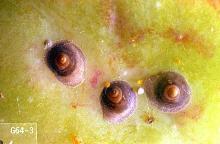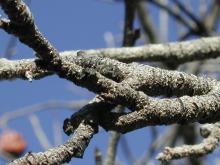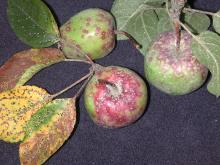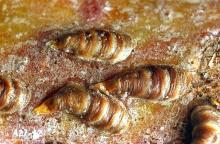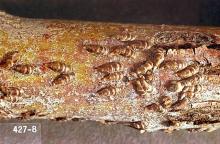Includes
Oystershell scale (Lepidosaphes ulmi)
San Jose scale (Quadraspidiotus perniciosus)
Pest description and crop damage The San Jose scale was introduced to the U.S. on flowering peach in the 1870s. It is now a pest of all fruit trees and many ornamental and wild trees and shrubs throughout the U.S., particularly in hot, dry climates. The oystershell scale is European in origin and has been in the US since around 1850. San Jose scale is differentiated from other scale insects by the scale (shell) that covers the adult females. The scale is hard, gray to black, and cone-shaped. The scale has a tiny white knob in the center with a series of grooves or rings around it. The oystershell scale looks like a miniature oyster. While the oystershell scale is principally a pest of woody parts of the plant (although it occasionally attacks fruit), the San Jose scale attacks woody parts and fruit. Scales are related to aphids, mealybugs, and whiteflies and have piercing-sucking mouthparts. Large populations of scale can devitalize plants and retard growth. Severe infestations by the San Jose scale can kill twigs and even the whole tree. Large quantities of honeydew are produced, which makes leaves and fruit shiny and sticky. Sooty mold may colonize the honeydew, giving the plants a dirty, sooty appearance, and further restricting photosynthetic activity. Fruit damaged by the San Jose scale is characterized by red halos that form around the feeding site.
Biology and life history The San Jose scale overwinters in an immature life stage and is black. In spring, the tiny winged males emerge and mate with wingless females. Females give birth to live young (no eggs) about a month later. The young scales, called "crawlers," are very small, flattened, and yellow, and move around on bark and foliage before settling down to feed. Young scales are dispersed by wind, rain, irrigation, or by the movement of people and machinery. Within days they secrete a waxy coating over their body that protects them from pesticides. From this point, female scales do not move. Crawlers are found during June and July and again from August to September, so there are two generations per year. The oystershell scale overwinters as eggs under the female scale. Crawlers emerge in May and June and move to feeding sites on the bark. They secrete a waxy coating and the females remain sedentary. Males emerge from their coating and mate with the females. Once the females lay eggs beneath their bodies, they gradually shrink in size and die after the last eggs are laid. There is one generation per year.
Scouting and thresholds Inspect twigs during the dormant season for scales. Pay particular attention to weak plants. Observe the young bark for purplish-red halos that indicate scale infestation. The crawlers are best observed during June to July with a 10X magnifying glass. Crawlers can be monitored by wrapping a piece of double-sided tape around an infested branch or by applying a tacky insect glue barrier.
Management-biological control
Larvae of green lacewings and other insects are aggressive predators of scale. However, biological control does not necessarily prevent significant scale infestations.
Management-cultural control
Scale can be rubbed off plants by hand with a glove or toothbrush. Major infestations can be pruned off. Tanglefoot, "stickem," or a similar adhesive can be applied around infestations of adult scales to catch the crawler stage. As with aphids, avoid excessive nitrogen fertilizer, as this favors increased scale populations.
Management-chemical control: HOME USE
Stages 0-1: Egg control with dormant & delayed-dormant sprays
Oils are effective against San Jose scale, but are not very effective against oystershell scale. Apply sprays during dormant or delayed-dormant period (March to April). Do not use after pink appears in buds. Use enough water to cover the tree thoroughly including small limbs and shoots.
- horticultural mineral oil-Some formulations OMRI-listed for organic use.
- horticultural mineral oil, plus one of the following: lime-sulfur, lime-sulfur materials such as polysulfide-Some formulations are OMRI-listed for organic use.
Spring and summer
Insecticide applications are aimed at the vulnerable crawlers during mid-summer. Apply insecticides about 10 days after full petal fall (all petals are off) or 17 to 21 days after full bloom. Avoid making applications of insecticides to plants in bloom to avoid bee injury. Follow all label directions.
- acetamiprid
- azadirachtin (neem oil)-Some formulations are OMRI-listed for organic use.
- carbaryl-Highly toxic to bees.
- gamma-cyhalothrin-Highly toxic to bees.
- imidacloprid-Soil drenches may have residual activity in woody plants lasting for 12 or more months. If short-term management is the goal, consider other approaches.
- insecticidal soap-Some formulations OMRI-listed for organic use.
- lambda-cyhalothrin-Highly toxic to bees.
- malathion-Highly toxic to bees.
- permethrin-Highly toxic to bees.
- plant-derived essential oils-Some have shown efficacy against scale. Some formulations are OMRI-listed for organic use.
- pyrethrins (often as a mix with other ingredients)-Highly toxic to bees. Some formulations are OMRI-listed for organic use.
- zeta-cypermethrin-Highly toxic to bees.
Management-chemical control: COMMERCIAL USE
Stages 0-2: Egg control with dormant & delayed-dormant sprays
- buprofezin (Centaur WDG) at 34.5 oz/A applied as a ground application using a minimum of 20 gallons of water per acre. Do not make more than one application per growing season. REI 12 hr. [Group 16]
- diazinon (Diazinon 50W) at 4 lb/A + horticultural mineral oil at 6 to 8 gal/A in up to 400 gal water. Do not apply more than one application as a dormant spray per year. REI 4 days. [Group 1B]
- horticultural mineral oil at 4 to 8 gal/A in up to 400 gal water. REI varies by formulation- See label.
- lime sulfur (calcium polysulfide)-Formulations vary; see label for rates. May be mixed with horticultural mineral oil at 6 to 8 gal/A in up to 400 gal water. REI 2 days. Some formulations are OMRI-listed for organic use.
- pyriproxyfen (Esteem 35WP) at 4 to 5 oz/A plus horticultural mineral oil at 4 to 8 gal/A in up to 400 gal water per application. Do not exceed two applications per season. Do not apply earlier than 14 days after last Esteem treatment. REI 12 hr. [Group 7C]
Stages 3-4: Prepink & tight cluster sprays
- buprofezin (Centaur WDG) at 34.5 oz/A applied as a ground application using a minimum of 20 gallons of water per acre. Do not make more than one application per growing season. REI 12 hr. [Group 16]
- diazinon (Diazinon 50W) at 4 lb/A in up to 100 gal water per application. Do not apply more than one application as an in-season spray per year. REI 4 days. [Group 1B]
- pyriproxyfen (Esteem 35WP) at 4 to 5 oz of product/A per 100 gal water per application. Do not exceed two applications per season. REI 12 hr. [Group 7C]
Pink & petal fall sprays
- buprofezin (Centaur WDG) at 34.5 oz/A as a ground application using a minimum of 20 gallons of water per acre. Do not make more than one application per growing season. REI 12 hr. PHI 14 days. [Group 16]
- pyriproxyfen (Esteem 35WP) at 4 to 5 oz/A in up to 100 gal water per application. Do not exceed two applications or 10 oz/A per growing season. REI 12 hr. PHI 45 days. [Group 7C]
Spring and summer
Long-term control can be achieved only with delayed-dormant sprays; however, fruit infestation can be prevented with summer applications.
- acetamiprid (Assail 70WP) at 3.4 oz/A in up to 100 gal water per application. Do not make more than four applications per year or exceed 13.5 oz/A per growing season. Will provide suppression. REI 12 hr. PHI 7 days. [Group 4A]
- buprofezin (Centaur WDG) at 34.5 oz/A as a ground application using a minimum of 20 gal water per acre. Do not make more than one application per growing season. REI 12 hr. PHI 14 days. [Group 16]
- diazinon (Diazinon 50W) at 4 lb of product/A in up to 100 gal water per application. Do not apply more than one application as an in-season spray. REI 4 days. PHI 21 days. [Group 1B]
- imidacloprid (Admire Pro) at 2.8 fl oz/A in up to 100 gal water per application. Do not use within 10 days prior to bloom or when bees are actively foraging. Do not exceed 14 fl oz/A per season. REI 12 hr. PHI 7 days. [Group 4A]
- pyriproxyfen (Esteem 35WP) at 4 to 5 oz/A in up to 100 gal water per application. Do not exceed two applications per growing season. REI 12 hr. PHI 45 days. [Group 7C]
- spirotetramat (Movento) at 6 to 9 fl oz/A. Do not exceed 25 fl oz /A per growing season. Apply after petal fall. REI 24 hr. PHI 7 days [Group 23].
- sulfoxaflor (Transform WG) at 0.75 to 1.5 oz/A in up to 100 gal water per application. Suppression only. See supplemental label. No more than four applications per season. PHI 7 days [Group 4C]


